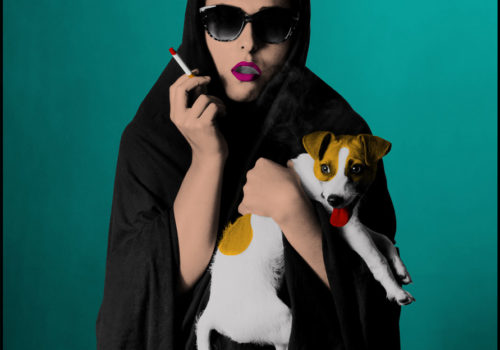Hoda Afshar’s series “Under Western Eyes” comprises digitally manipulated photographs that are designed to shift the conversation around the representation of Islamic women as subjugated and suppressed. Afshar, who is originally from Iran now lives in Melbourne where she is a practicing photographic artist.
Afshar believes “Veiled women are often described as a homogeneous group and mostly pictured as powerless subjects with their veil either symbolizing oppression or an exotic commodity. If you look closely at the art world, you’ll notice that in the past few decades, the images of women in the veil have been regularly appearing in contemporary art exhibitions. Most are held in the famous metropolitan centres of the West – London, New York and Paris – typically showing Islamic women as an identical group of victims“.
“In Western societies, the veil is mostly seen as unknown, threatening and mysterious and it always provokes strong reactions and counter-reactions. What is quite interesting to me though, is the paradoxical nature of these reactions that are often changed by the world events and responses towards Muslim communities.”
Afshar says her intention with this series is to “question the system in which these stereotypes are fabricated and commoditized and also question the works of many of the artists of Muslim background whose practices feed into this climate of sympathy for Islamic women”.
In “Under Western Eyes” she has drawn inspiration from Australian artist Richard Bell’s “Aboriginal art – it’s a white thing” theorem, in which he examines the commoditization of the Aboriginal art market by the West. Where Bell referenced Jackson Pollock and abstract expressionism, Afshar has turned to pop art and Andy Warhol to assert her belief that the “West is the dominant producer and consumer of this kind of imagery”. Through the appropriation of “the most clichéd images, or celebrated portraits, of veiled women” Afshar says this series suggests “Veil art, it is a white thing!”
She explains further. “Warhol’s commercial style was intended to flatten the complexity of the subject and reduce it to a product of consumption. So by using it in my work, my intention is to emphasise the reductive interpretation of the identity of Muslim women in the West”.
Afshar doesn’t dispute the veil “as a forced enclosure” and has no intention “to deny the oppression of many women in Islamic regions. I just believe that this issue has been strongly highlighted, overtly discussed and has become the only expected theme in representing the identity of Muslim women in the West. I do not judge that all the women who wear the veil are forced into it; for many it is a personal choice that they make based on their religious or cultural beliefs. Not all women of the Islamic background wear the veil or share the same belief or ideology, but unfortunately in the West, we only get to hear the voices of misery and negativity”.
This focus on subjugation is what Afshar refers to when she speaks of ‘exoticism,’ which she says in this context is best defined by post-colonial writer Graham Huggan “as a political and an aesthetic practice, which has proved over time to be an effective instrument of imperial power.” In this context ‘exoticim refers to the process of transforming and translating cultural differences into a familiar language where it can be easily understandable and smartly commodified.’ Afshar says the political function of exoticism as Huggan describes “is to guarantee the availability of the marginal cultures for the Western mainstream as well as ensuring to keep the mainstream out of harmful reach… I think that Huggan’s analysis clearly justifies the recent love affair of the world art market with the veil as an exotic commodity and in general the fascination with the art of the Middle Eastern, African and Asian marginal”.
It is Afshar’s hope that her images will “widen the field of discussion…for a long time I have felt the need of a dialogue wherein we can hear the voices of multiple experiences of Islamic women, a dialogue that is opposed to these politically correct forms of representation. Whether or not I’ve been successful in questioning the structures of power relations in the art work, I offer a space in which viewers can discuss these issues and exchange other perspectives,” she concludes.
EXHIBITION
Under Western Eyes
by Hoda Afshar
Until 3 May 2014
Edmund Pearce
Level 2
Nicholas Building
37 Swanston Street
Melbourne
Australia
















